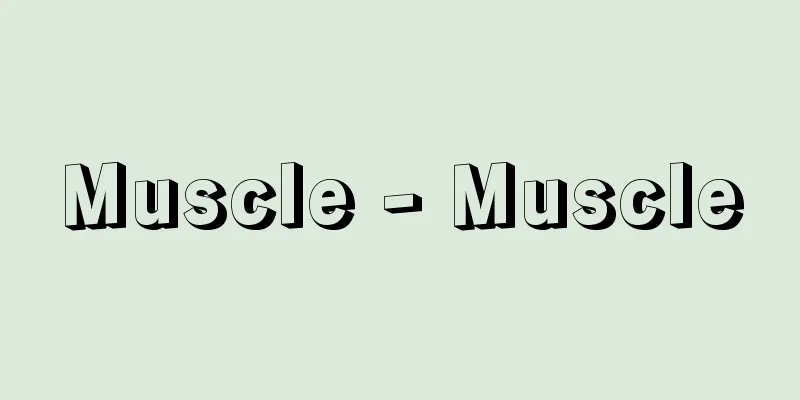Muscle - Muscle

|
An organ involved in bodily movement, also called a muscle. Morphology in humansMuscles are classified into three types based on their structure and function. The first type is skeletal muscle, which is attached mainly to the skeleton and moves and supports it. The second type is cardiac muscle, which forms the walls of the heart. The third type is visceral muscle, which is distributed widely among the internal organs and controls the movement of these organs in a broad sense. When people say muscle, they usually mean skeletal muscle. The main body of muscle movement is the muscle cells (also called muscle fibers), and the contraction of each muscle cell causes the contraction activity of the entire muscle. These muscle cells are classified into striated muscle cells, which have horizontal stripes (striations) visible under an optical microscope, and smooth muscle cells, which do not. Skeletal muscle and cardiac muscle are composed of striated muscle cells, and visceral muscle is composed of smooth muscle cells. Skeletal muscle is called voluntary muscle because it can be moved by will, while cardiac muscle and visceral muscle are called involuntary muscle because they move regardless of will. This is because skeletal muscles are controlled by motor nerves that transmit signals of will, whereas visceral muscles and cardiac muscles are controlled by autonomic nerves. However, in addition to being controlled by the autonomic nerves, cardiac muscles also have a stimulus conduction system (also called an excitation conduction system) inside them that automatically repeats contraction movements without receiving signals from the autonomic nerves. Skeletal muscles are made up of muscle cells that gather together to form muscle bundles, and several of these bundles form a single muscle, but each muscle is surrounded by fascia, a type of connective tissue. Skeletal muscles are attached between one bone and another by tendons that migrate from muscle tissue. When a skeletal muscle moves a bone, the attachment that moves with the bone is called the insertion, and the attachment that is fixed to the bone is called the origin. Skeletal muscles are classified into fusiform, pennate, semipennate, biceps, triceps, circular, and digastric muscles based on their shape, and further classified into flexor, extensor, adductor, abductor, rotator (pronator and supinator in the case of the limbs), elevator, depressor, sphincter, and dilator muscles based on the muscle's function. Skeletal muscles are almost always active in groups rather than individually, and the main force that performs the function is called the primary agonist. During activity, antagonistic muscles perform opposing actions, while synergistic muscles perform the same action as the primary agonist muscles at the same time. Muscle cells, which are responsible for muscle contraction, vary depending on the size of the muscle, but striated muscle cells range in length from a few millimeters to 15 centimeters and are about 10 to 100 micrometers thick (1 micrometer is one millionth of a meter). Smooth muscle cells also vary depending on the organ in which they are distributed, but the standard length is about 40 to 200 micrometers, and in blood vessel walls it is about 20 micrometers. They are about 4 to 20 micrometers thick. In the walls of pregnant uteruses they can reach a length of about 500 to 800 micrometers. Within the cytoplasm (also called sarcoplasm) of muscle cells, myofibrils (also called myofibrils) run along the longitudinal axis of the cell, and these myofibrils are the basis of contractile activity. The striations of muscle cells are the result of the convergence of the striations present in the myofibrils. The striations of myofibrils are caused by the alternating periodic arrangement of the bright, monorefractive I band (isotropic band) and the dark, birefringent A band (anisotropic band), with the A band being somewhat wider. In the center of the I band, a thin, dark line exists like a partition. This is called the Z membrane, and the space between the Z membranes is called the sarcomere, which is the unit of myofibril structure and contractile activity. When observed under an electron microscope, myofibrils are composed of two types of filaments (sarcomeres) that are regularly arranged. One is the thick filament (myosin filament; approximately 1.5 micrometers long and 100-150 angstroms thick; 1 angstrom is 0.1 nanometers; 1 nanometer is one billionth of a meter), and the other is the thin filament (actin filament; approximately 1 micrometer long and 50-70 angstroms thick). The thick filaments are arranged at regular intervals along the entire length of the A band, while the thin filaments arise from both sides of the Z membrane and extend to both sides, inserting themselves between the thick filaments of the A band. The dark A band is the area where both filaments overlap, and the I band is the area where only thin filaments are arranged. Both filaments are made up of protein molecules. It is thought that contraction of muscle fibers occurs when the thin filaments slide deeper into each other between the thick filaments. Two types of filaments can be distinguished in smooth muscle fibers, but thick filaments are variable. The striated structure of cardiac muscle fibers is the same as that of skeletal muscles. Skeletal muscles are divided into red muscles, which appear red to the naked eye, and white muscles, which appear whitish; red muscles have fewer myofibrils and are rich in sarcoplasm, while white muscles have dense myofibrils and less sarcoplasm. Red muscles perform slow, sustained movements and do not tire easily, while white muscles perform rapid movements and tire easily. In humans, there are few pure red and white muscles, but the soleus muscle, which is part of the triceps surae, and the eye muscles have many red muscle cells, while the abdominal muscles and the sternocleidomastoid muscle in the neck have many white muscle fibers. Skeletal muscles are primarily involved in bone movement (exercise), and there are approximately 400 of them in the body. However, some skeletal muscles are attached to the skin and move it (cutaneous muscles). Examples of cutaneous muscles include the facial muscles that change facial expressions and the platysma muscle that creates wrinkles in the skin in the neck. Skeletal muscles have various accessory devices to facilitate and make their action more effective, including tendon sheaths, muscle pulleys, fascia, and bursae. Motor nerves are distributed in each skeletal muscle and send signals to contract the muscle, but a single motor nerve fiber branches within the muscle and reaches many muscle cells, forming a special device called a motor endplate on the surface of each muscle cell and transmitting excitation to the muscle cell. Sensory nerves send information about the tension state of the muscle to the central nervous system, and the stimulus receiving device distributed by these nerve fibers is called a muscle spindle. This muscle spindle is a stretch receptor. [Kazuyo Shimai] Muscles and ContractionsThe function of a muscle is to shorten its length, which is called contraction. Contraction in this case does not mean that the volume of the muscle shrinks, as occurs when salt is sprinkled on a slug or hot metal is cooled; rather, the volume remains almost constant at all times, and only the length shortens. Therefore, the thickness of a contracting muscle becomes thicker than before it contracts. A bicep is a muscle in the upper arm that has become thicker due to contraction. As mentioned above, contraction is a phenomenon common to skeletal muscle, cardiac muscle, and smooth muscle, but the speed of contraction differs for each. Skeletal muscle contracts very fast, cardiac muscle contracts next, and smooth muscle contracts extremely slowly. In the case of skeletal muscle, joints move and movement is performed by contraction. Our body has about 400 skeletal muscles of various sizes, which can perform rapid and complex movements. Cardiac muscle and visceral muscle are not related to bones, but are distributed in the walls of bag-like organs, and when these muscles contract, the contents of the bag are pushed out. For example, the heart pushes out blood, and the bladder pushes out urine. When we look at the phenomenon of contraction in skeletal muscles, first, when an impulse from a motor nerve reaches the end plate of a muscle fiber, an action potential is generated in the muscle. Next, excitation-contraction coupling occurs, in which the electrical phenomenon of the action potential is converted into the mechanical phenomenon of shortening. Finally, contraction occurs as filaments slide against each other. All of this takes place through the fine structures within the muscle fiber. When a muscle fiber is sliced very thinly and the inside of a sarcomere is viewed under an electron microscope, it is clear that the thin myofibrils, which are barely visible under a normal microscope, are in fact a collection of even thinner filaments. As mentioned before, there are two types of filaments: thick filaments and thin filaments. When a cross section is taken of the overlapping area between the two, it is clear that six thin filaments neatly surround one thick filament. Thick filaments are made up of a protein called myosin, while thin filaments are primarily composed of a protein called actin. In addition to actin, thin filaments contain proteins called troponin and tropomyosin. [Hidenobu Mashima] Excitation-contraction coupling (from electrical signals to contraction)Excitation of muscle fibers, i.e., an action potential that starts at the end plate, propagates along the cell membrane on the surface of the muscle fiber to the end, but since the cell membrane becomes a transverse tubule at the Z membrane and penetrates to the center of the muscle fiber, the action potential propagates along this tubule to the inside of the muscle. The change in membrane potential caused by the action potential releases calcium ions stored in the sarcoplasmic reticulum inside the sarcomere. The released calcium ions bind to troponin on the thin filaments, causing deformation of tropomyosin. Tropomyosin is in a position that prevents the thick filament myosin from binding to the thin filament actin, but this obstruction is removed by deformation, and the head of the myosin molecule binds to actin to form a crossbridge. Myosin has the enzyme activity of adenosine triphosphate (ATP), so ATP is decomposed, and the energy generated moves the crossbridge, causing the thin filaments and thick filaments to slip away from each other. After the movement, the bridge immediately dissociates and returns to its original state, but if the calcium ion concentration is sufficient, the tropomyosin is not obstructed and a bridge is formed again, and the slippage continues. In this way, the thin filaments are gradually pulled into the center of the thick filaments, and the overall length of the muscle fiber is eventually shortened. This is called the "sliding theory of muscle contraction." When calcium ions are taken up into the sarcoplasmic reticulum and the concentration decreases, tropomyosin is inserted between actin and myosin, bridge formation stops, and the muscle relaxes. [Hidenobu Mashima] Strength and workWhen a skeletal muscle contracts and lifts a weight, that is, when it shortens and lifts a weight a certain distance, it is said to have done "work equivalent to the product of the weight and the distance." In contrast, when a skeletal muscle is simply supporting a weight and does not move, the distance of the lift is zero and it does no work. However, since the muscle is exerting a force sufficient to support the weight, in this case it is said to have "exerted a muscular force equal to the weight." In either case, a sufficiently large number of impulses must be sent to the muscle. For example, even during "light effort," when the amount of work done by the muscle is small, the number of impulses traveling through one motor nerve is more than 10 per second, and thousands of nerve fibers are involved. Furthermore, one nerve fiber contracts up to 100 muscle fibers. During "maximum effort," when the muscle is contracting most vigorously, the frequency of impulses is more than 50 per second. When this mechanism of work is considered for a single motor nerve, the force exerted during a single impulse (twitch) is only one-third to one-fifth of the force exerted during maximum effort (tetanus). Maximum muscle force is proportional to the cross-sectional area of the muscle fiber involved, which is approximately 5-6 kg per square centimeter in humans and 3-4 kg per square centimeter in frogs. [Hidenobu Mashima] Energy consumptionMuscles consume energy through contraction, but not all of the energy is converted into work; more than 75% becomes heat. When contracting to support a weight, no work is done, so all the energy is dissipated as heat. In this way, muscle contraction is accompanied by heat production, so the body warms up when exercising. The ratio of the part of the energy that becomes work to the part that becomes heat, that is, "efficiency," improves the more weight is pulled and the slower the contraction speed, but it worsens when a certain weight is exceeded or when the contraction speed is too slow. For example, when climbing stairs with a normal gradient, the most efficient speed is about one step per two seconds. Muscle contraction is performed by the energy from ATP decomposition, but ATP in the muscles does not decrease even if the contraction continues. This is because there is an abundance of creatine phosphate in the muscles, and phosphate is added to adenosine diphosphate (ADP) generated by ATP decomposition to turn it back into ATP, which itself becomes creatine. As a result, creatine phosphate is consumed and creatine increases, but ATP is not consumed unless creatine phosphate is depleted. ATP is synthesized as a result of metabolism, such as glycolysis, in which glucose in the muscle is broken down, and intracellular respiration. In muscles that have finished contracting, the above reactions proceed in the exact opposite direction, and creatine phosphate accumulates again. As a result of the glycolysis process, glucose is broken down into lactic acid, but if there is a sufficient supply of oxygen, lactic acid is not produced, and the glycolysis products are coupled with respiration to produce only water and carbon dioxide, and ATP synthesis is also significantly more efficient. For example, the amount of ATP synthesized for the decomposition of one molecule of glucose is 19 times higher than when there is no oxygen supply at all. As a result, about 5 calories of energy are generated per milliliter of oxygen consumed. Therefore, when performing intense exercise or contraction, it is important to have a sufficient supply of oxygen. Glucose and oxygen are transported to the muscles by the blood. In order to ensure sufficient oxygen supply during exercise, breathing must be stimulated to increase the oxygen concentration in the blood and blood circulation in the muscles must be increased. For this reason, the heart rate increases during exercise, and the resting capillaries in the muscles open, allowing a large amount of blood to flow. [Hidenobu Mashima] Muscle fatigueAs muscles continue to contract, muscle strength gradually weakens, and the amount of shortening or force decreases. This is called muscle fatigue. It is thought that the cause is the accumulation of fatigue substances within the muscles. Fatigue substances, such as lactic acid, are produced in large quantities as a result of glycolysis when oxygen supply is insufficient, making the muscles acidic, and preventing the enzymes that act as catalysts for various chemical reactions from functioning properly. As a result, overused muscles become stiff. Generally, fatigue does not simply mean muscle fatigue, but also fatigue in the area where excitation is transmitted from the nerves to the muscles and in the neural mechanisms in the brain, so that even if the muscles themselves are not necessarily fatigued, the phenomenon of poor movement and a feeling of fatigue occurs. However, even in such cases, the cause is often an increase in acids such as lactic acid and carbon dioxide in the blood. [Hidenobu Mashima] Animals and musclesMuscles, that is, tissues that are collections of cells (muscle cells) that contain the contractile proteins actin and myosin and can actively contract and relax, are present in all metazoans except for sponges. Sponges have myocytes, which are considered to be the embryonic form of muscle cells. Muscle cells are usually long and thin, so they are also called muscle fibers (in human physiology, myofibers). The muscles of vertebrates, crustaceans, and mollusks are voluminous and often delicious, and most of them are used as meat. The skeletal and cardiac muscles of vertebrates are striated muscles, while the muscles of the internal organs and blood vessels are smooth muscles. Invertebrates also have striated and smooth muscles, but in addition to these, some mollusks and annelids have oblique striated muscles. Oblique striated muscles are muscles that have stripes that run diagonally in the longitudinal direction of the muscle. Skeletal muscles of vertebrates have connective tissue tendons at both ends that connect them to the skeleton. The tendons further cover the entire muscle and form the peritendinous membrane. Muscle fibers are multinucleated syncytia, which are long and slender and extend from one end of the muscle to the other. In contrast, cardiac and smooth muscles are made up of relatively short, cylindrical or spindle-shaped, mononucleated muscle cells that are arranged almost parallel to each other and connected in a mesh-like pattern. The walls of the digestive tract and blood vessels contain layers of circular and longitudinal muscles, each with its own unique course, that are tightly bound to layers of connective tissue. Muscle fibers contain thick filaments, mainly myosin, and thin filaments, mainly actin, which are regularly arranged in striated muscles, resulting in the formation of A-bands and I-bands, just as in humans. When viewed in cross section, each filament is regularly arranged in a hexagonal lattice. The actin and myosin molecules that make up both filaments are also regularly arranged in double helices, making it possible to study by X-ray diffraction what happens to the structure of the macromolecules within the myofibrils in the respective states of contraction and relaxation. The way muscles contract varies depending on the type of muscle. The twitch fibers of vertebrate skeletal muscles and cardiac muscles perform a rapid, transient contraction called a twitch in response to a single action potential. The twitch of each muscle fiber follows the "all-or-none" principle with respect to the stimulus that causes it. The "all-or-none" principle states that when the action potential of a single muscle fiber is weak, no reaction occurs, but when the stimulus reaches a certain strength, a certain reaction (contraction) occurs, and the magnitude of the reaction does not vary depending on the strength of the stimulus. However, in skeletal muscles, when the strength of the stimulus is increased, the number of muscle fibers that respond to it increases, and the magnitude of the twitch of the muscle as a whole can increase. In cardiac muscles, because there is electrical coupling between the muscle fibers, the muscle as a whole also follows this law. In skeletal muscle twitch fibers, when action potentials are repeated at appropriate intervals, a phenomenon called twitch summation occurs. If the "repetition frequency" is high enough, a sustained contraction (tetanic contraction) several times larger than the twitch occurs while the action potential continues. Unlike cardiac muscle, the refractory period of the action potential is long, so tetanic contraction does not normally occur even in response to "repetitive stimulation". In addition, among the skeletal muscle fibers of vertebrates, slow fibers found in frogs, etc., as well as smooth muscle of vertebrates and muscles of invertebrates, contract in stages according to the degree of depolarization. Depolarization is a state in which the electric potential inside the cell, which is generally negative across the cell membrane, decreases when an electric current is applied. In this contraction, if the depolarization is localized, the contraction is also localized, and it usually continues as long as the depolarization continues, so it is often called tension. The smooth muscle of the adductor muscle of bivalve shellfish can maintain tension for a long time without depolarization. The energy consumption for this is extremely small, and it is thought to be due to a special mechanism, and it is called a catch contraction by a ratchet mechanism. Skeletal muscles of vertebrates contract under the control of motor nerves, while cardiac and smooth muscles are under the control of autonomic nerves and hormones. Many invertebrate muscles are also under the control of nerves and hormones, and some, such as the skeletal muscles of crustaceans, are under double or triple nerve control. The mechanism of contraction is as described above in "excitation-contraction coupling," but this interaction is activated by calcium ions. Therefore, in order for contraction to occur, the calcium ion concentration around the filament must be increased. The site of action of calcium ions is troponin, which is present on the thin filament in vertebrate skeletal muscles, but on the thick filament in adductor muscles of bivalves. There are also some muscles of insects that have calcium ions on both filaments. In this way, calcium ions activate contraction, but in the asynchronous flight muscles of insects, this is not sufficient, and further activation occurs when the muscles are appropriately stretched. This property allows asynchronous flight muscles to resonate with the elastic support structure, enabling them to perform high-frequency rhythmic contractions of up to several hundred times per second. [Shoji Baba] "Cell Movement" edited by the Zoological Society of Japan (1974, University of Tokyo Press)" ▽ "Biophysical Society of Japan edited by the Biophysical Society of Japan (1982, Society Publication Center)" [References] | | | | | |Muscles are mainly attached to the skeleton and control its movement, and are also called skeletal muscles. Some muscles are attached to the skin of the face and help with facial expressions, while others are attached to internal organs and are involved in vocalization, swallowing, defecation, and eye movement . Human muscular system (front) ©Shogakukan "> Human muscular system (posterior view) ©Shogakukan "> Major muscles and their activities ©Shogakukan "> Muscle structure ©Shogakukan "> Animal muscle structure ©Shogakukan "> Two types of insect flight muscles Source: Shogakukan Encyclopedia Nipponica About Encyclopedia Nipponica Information | Legend |
|
身体の運動にかかわる器官で、筋ともいう。 ヒトにおける形態筋は、その構造と働きのうえから3種類に分類される。第一は、主として骨格に付着して骨格を動かしたり支えたりする骨格筋、第二は、心臓の壁をつくっている心筋、第三は、内臓器官のなかに広く分布し、それらの器官を動かす広い意味での運動をつかさどる内臓筋である。一般に筋肉という場合には、骨格筋をさして使われることが多い。筋の運動の主体となるのは筋を構成する筋細胞(筋線維ともいう)で、個々の筋細胞が収縮して筋全体の収縮活動となる。この筋細胞には、光学顕微鏡下で横縞(よこじま)(横紋)の見える横紋筋細胞と、横縞の見られない平滑筋細胞がある。骨格筋と心筋は横紋筋細胞からなり、内臓筋は平滑筋細胞で構成されている。また、骨格筋は意志によって動かせるために随意筋とよばれ、心筋と内臓筋とは意志に関係なく動くので不随意筋とよばれる。これは、骨格筋の支配が意志の信号を伝える運動神経によって行われるのに対し、内臓筋、心筋の支配は自律神経によって行われるためである。しかし、心筋は自律神経支配のほかに、自律神経の信号を受けなくても自動的に収縮運動を繰り返す刺激伝導系(興奮伝導系ともいう)を心筋の内部にもっている。 骨格筋は筋細胞が集合して筋束をつくり、それがいくつか集まって1個の筋個体を形成するが、それぞれの筋個体は結合組織性の筋膜によって包まれる。また、骨格筋は一つの骨と他の骨との間にわたって付着するが、この付着は筋組織から移行する腱(けん)によって行われている。骨格筋が骨を動かす場合、骨とともに移動する付着部を停止部、骨とともに固定している付着部を起始部という。骨格筋はその形によって紡錘状筋、羽状筋、半羽状筋、二頭筋、三頭筋、輪状筋、二腹筋などに区別され、さらに筋の働きによって屈筋、伸筋、内転筋、外転筋、回旋筋(手足の場合、回内筋、回外筋)、挙上筋、下制筋、括約筋、散大筋などに分類される。また骨格筋は、ほとんどの場合、単独筋よりも複数筋で活動するが、その働きの主力となるものを主要作動筋とよぶ。活動の際、相反する働きを行うのが拮抗筋(きっこうきん)であり、主要作動筋と同じ働きを同時に行うのが協力筋である。 筋の収縮活動の主体である筋細胞は、筋の大きさによってさまざまであるが、横紋筋細胞の長さは約数ミリメートルから15センチメートルにおよび、太さは約10~100マイクロメートル(1マイクロメートルは100万分の1メートル)。平滑筋細胞も分布する器官によってさまざまであるが、標準的な長さは約40~200マイクロメートル、血管壁では約20マイクロメートルとなる。太さは約4~20マイクロメートル。妊娠子宮壁では長さ約500~800マイクロメートルにも達する。 筋細胞の細胞原形質(筋形質ともいう)内には筋原線維(筋細線維ともいう)が細胞の長軸方向に走り、この筋原線維が収縮活動の基本となっている。筋細胞の横紋は、筋原線維に存在する横紋の集束の結果として現れたものである。筋原線維の横紋は、単屈折性の明るいI帯isotropic bandと複屈折性の暗いA帯anisotropic bandとが交互に周期的配列を示すことによるもので、A帯はやや幅が広い。I帯の中央には、暗調の細い線が仕切りのように存在する。これをZ膜といい、Z膜とZ膜との間を筋節(きんせつ)(サルコメア)とよび、筋原線維の構造および収縮活動の単位となる。筋原線維を電子顕微鏡で観察すると、規則的に配列する2種類のフィラメント(筋細糸)からなっている。その一つは太いフィラメント(ミオシンフィラメント。長さ約1.5マイクロメートル、太さ約100~150オングストローム。1オングストロームは0.1ナノメートル。1ナノメートルは10億分の1メートル)、他の一つは細いフィラメント(アクチンフィラメント。長さ約1マイクロメートル、太さ約50~70オングストローム)で、太いフィラメントはA帯の全長にわたって互いに一定間隔で配列し、細いフィラメントはZ膜の両側からおこり、両側に伸びてA帯の太いフィラメントのそれぞれの間に入り込んでいる。暗調のA帯は両フィラメントが重なった部分であり、I帯は細いフィラメントのみの配列部分である。両フィラメントはタンパク分子から構成されている。筋線維の収縮は、太いフィラメントの間に細いフィラメントが互いにさらに深く滑り込むことで生じると考えられている。 平滑筋線維のフィラメントでは2種類のフィラメントが区別できるが、太いフィラメントは不定に存在する。心筋原線維の横紋構造は骨格筋と同じである。 骨格筋には肉眼的に赤くみえる赤筋(せききん)と、白っぽくみえる白筋(はくきん)とがあり、赤筋は筋原線維が少なく、筋形質に富み、白筋は筋原線維が密在し、筋形質が少ない。赤筋は緩慢で持続的な運動を行い、疲れにくいが、白筋は急速な運動を行い、疲れやすいとされる。人間では純粋な赤筋、白筋は少ないが、下腿三頭筋(かたいさんとうきん)の一部であるヒラメ筋、眼筋などは赤筋細胞が多く、腹筋や頸部(けいぶ)の胸鎖乳突筋などは白筋線維が多いとされている。 骨格筋はもっぱら骨の動き(運動)に関与する筋で、全身には約400個存在する。しかし、骨格筋のなかには、皮膚に付着して皮膚を動かす筋(皮筋)がある。顔の表情を変える顔面筋、頸部で皮膚にしわをつくる広頸筋などが皮筋の例である。 骨格筋には、その活動を円滑にし、効果的にさせるためにさまざまな補助装置がある。これら補助装置には腱鞘(けんしょう)、筋滑車、筋膜、滑液包などが含まれる。 個々の骨格筋には運動神経が分布し、筋の収縮信号を送るが、1本の運動神経線維は筋内で分岐し多数の筋細胞に到達し、個々の筋細胞の表面で運動終板とよぶ特別な装置をつくり、興奮を筋細胞に伝える。筋の緊張状態の情報を中枢に送るのは感覚神経で、その神経線維が分布している刺激受容装置を筋紡錘という。この筋紡錘は伸張受容器である。 [嶋井和世] 筋肉と収縮筋肉の働きとは、その長さが短くなることであり、これを収縮という。この場合の収縮とは、ナメクジに塩をかけたり、熱い金属を冷やしたりするときのように体積が縮小するわけではなく、いつでも体積はほぼ一定で、長さだけが短くなるということである。したがって、収縮している筋肉の太さは、収縮前よりも太くなる。力こぶというのは上腕の筋肉が収縮によって太くなったものである。以上のように、収縮するということは骨格筋、心筋、平滑筋の三者に共通の現象であるが、収縮の速さはそれぞれに異なる。骨格筋は非常に速く、心筋がこれに次ぎ、平滑筋はきわめてゆっくりである。骨格筋の場合は、収縮によって関節が動き、運動が行われる。われわれの身体には約400個の大小さまざまな骨格筋があって、急速で複雑な運動を行える。心筋や内臓筋は骨とは関係がなく、袋状の臓器の壁に分布しているので、これらの筋が収縮することによって袋の内容が押し出される。たとえば、心臓は血液を、膀胱(ぼうこう)は尿を押し出すなどである。 骨格筋について収縮という現象を調べてみると、まず運動神経からのインパルスが筋線維の終板部に達すると、筋に活動電位が発生する。ついで活動電位という電気的な現象が、短縮という力学現象に変換される興奮収縮連関がおこる。そして最後に、フィラメントの滑り合いによって収縮がおこるわけである。これらはすべて筋線維内の微細な構造をめぐって行われる。 筋線維をごく薄く切って筋節内を電子顕微鏡で見ると、普通の顕微鏡ではやっと見えるような細い筋原線維も、実はさらに細いフィラメントの集まりであることがわかる。フィラメントには、太いフィラメント、細いフィラメントの2種類があることは前に述べられているとおりである。両者の重なり合った部分を横断面でみると、1本の太いフィラメントの周囲を6本の細いフィラメントが整然と囲んでいることがわかる。太いフィラメントはミオシンというタンパク質からなり、細いフィラメントはアクチンというタンパク質を主成分とする。細いフィラメントにはアクチンのほか、トロポニン、トロポミオシンというタンパク質がついている。 [真島英信] 興奮収縮連関(電気信号から収縮へ)筋線維の興奮、すなわち終板部に始まった活動電位は、筋線維表面の細胞膜上を末端まで伝播(でんぱ)していくが、細胞膜はZ膜部で横行小管となって筋線維の中央まで入り込んでいるので、活動電位はこの小管に沿って筋内部まで伝播していく。活動電位による膜電位の変化は、筋節内部にある筋小胞体に蓄えられているカルシウムイオンを放出させる。放出されたカルシウムイオンは、細いフィラメント上にあるトロポニンと結合し、トロポミオシンの変形をもたらす。トロポミオシンは、太いフィラメントのミオシンと細いフィラメントのアクチンとが結合することを妨げるような位置にあるが、変形によってこの妨害は除かれ、ミオシン分子の頭部がアクチンと結合して連結橋(クロスブリッジ)を形成する。ミオシンにはアデノシン三リン酸(ATP)分解酵素作用があるので、ATP分解がおこり、そのエネルギーによって連結橋が運動し、細いフィラメントと太いフィラメントとは互いにずれ合う。運動し終わった連結橋はただちに解離し、元に戻るが、もしカルシウムイオン濃度が十分ならば、トロポミオシンの妨害は除去されたままとなり、ふたたび連結橋が形成され、ずれ合いが続くことになる。このようにして、しだいに細いフィラメントは太いフィラメントの中央へ手繰り込まれていき、結局は筋線維全体の長さが短縮していくことになる。これを「筋収縮の滑走説」という。カルシウムイオンが筋小胞体に取り込まれ、その濃度が低下すると、トロポミオシンがアクチンとミオシンの間へ割り込む形となり、連結橋形成はおこらなくなって、筋は弛緩(しかん)する。 [真島英信] 筋力と仕事骨格筋が収縮して、ある重量を持ち上げる場合、つまり、短縮によってある重量をある距離だけ引き上げたとき、「重量と距離との積に相当する仕事をした」という。これに対して、骨格筋がある重量を単に支えているだけで動かないときは、引上げの距離はゼロになって仕事はしない。しかし、筋は重量を支えるだけの力を出しているので、この場合は、「重量に等しい筋力を出した」という。いずれの場合にしても、十分に多量のインパルスが筋に送り込まれなければならないわけである。たとえば、筋の仕事量が少ない「軽い努力」のときでも、1本の運動神経を伝わっていくインパルスの数は毎秒10発以上であり、しかも何千本という神経線維が関与している。さらに、1本の神経線維は100本にも及ぶ筋線維を収縮させている。筋の収縮がもっとも盛んな「最大努力」のときのインパルスの頻度は毎秒50発以上という数になる。この仕事の仕組みを1本の運動神経について考えると、インパルスがただ1発しかこないとき(単収縮のとき)の力は、最大努力のとき(強縮のとき)の力の3分の1から5分の1にすぎないことになる。最大筋力は関与する筋線維の横断面積に比例するが、その値は1平方センチメートル当り、ヒトではおよそ5~6キログラム、カエルではおよそ3~4キログラムである。 [真島英信] エネルギー消費筋は収縮によってエネルギーを消費するが、エネルギーの全部が仕事に変わるのではなく、75%以上は熱になってしまう。重量を支えるような収縮のときは、仕事をしないので、エネルギーは全部熱となって放散される。このように筋の収縮は熱産生を伴うので、運動すると体が温かくなる。エネルギーのうち仕事になる部分と熱になる部分との比、すなわち「効率」は、引き上げる重量が大きいほど、また収縮の速度が遅いほどよくなるが、一定の重量を超えるか、あまりにゆっくりと短縮する場合はかえって悪くなる。たとえば、普通の勾配(こうばい)の階段をあがる場合についてみると、2秒に1段くらいの速度がもっとも効率がよいことになる。筋の収縮はATP分解のエネルギーによって行われるが、収縮を続けても筋内のATPは減少しない。これは、筋内にはクレアチンリン酸が豊富に存在し、ATP分解の結果生じたアデノシン二リン酸(ADP)にリン酸を与えてふたたびATPとし、自らはクレアチンとなるためである。この結果、クレアチンリン酸が消耗してクレアチンが増加するが、ATPはクレアチンリン酸がなくならない限り消耗しないわけである。ATPは筋内のブドウ糖が分解する反応、すなわち解糖や、細胞内呼吸などの代謝の結果合成される。収縮の終わった筋では以上の反応がまったく逆向きに進行し、結局、クレアチンリン酸がふたたび蓄積されていく。ところで、解糖過程の結果、ブドウ糖は乳酸に分解されるが、もし酸素の供給が十分ならば、乳酸は発生せず、解糖産物は呼吸と共役して水と二酸化炭素だけを生じ、ATP合成も著しく能率がよくなる。たとえば、酸素の供給のまったくない場合に比較して、1分子のブドウ糖分解について合成されるATPの量は19倍にもなる。その結果、酸素消費1ミリリットル当り約5カロリーのエネルギーが生成される。したがって、激しい運動や収縮を行う場合は、酸素の供給が十分であるかどうかが重要な問題となる。ブドウ糖や酸素は血液によって筋に運ばれる。運動中、酸素供給を十分に行うためには、呼吸運動を盛んにして血液中の酸素濃度を高めるとともに、筋の血液循環量を多くしなければならない。このため、運動時では心拍数が増加し、筋肉の休止毛細血管も開いて多量の血液が流れるわけである。 [真島英信] 筋疲労筋が収縮を続けていると、しだいに筋力が弱まり、短縮量あるいは力が減少していく。これを筋疲労という。その原因は、疲労物質が筋内にたまるためと考えられている。疲労物質とはたとえば乳酸などで、酸素の供給が十分でない場合は、解糖の結果、こうした物質が多量に生じ、筋内が酸性に傾き、種々の化学反応の触媒として働く酵素の機能がうまく果たせないことになる。その結果、使いすぎた筋にいわゆる「凝(こ)り」がおこるわけである。一般に疲労というときは、単に筋疲労だけでなく、神経から筋に興奮が伝達されるところや、脳内の神経機序(メカニズム)の疲労も加わるために、かならずしも筋肉自体は疲労していないのに、動きが悪くなったり、疲労感を覚えるという現象がおこる。しかし、このような場合も、血液中に乳酸や二酸化炭素のような酸が多くなることにその原因があることが多い。 [真島英信] 動物と筋肉筋肉、すなわち収縮性タンパク質のアクチンとミオシンを含み、能動的収縮、弛緩を行うことのできる細胞(筋細胞)の集まりである組織は、海綿動物を除くすべての後生(こうせい)動物に存在する。海綿動物には筋細胞の萌芽(ほうが)的形態とされるミオサイトがある。筋細胞は、普通細長いために筋繊維(ヒト生理学では筋線維)ともよばれる。脊椎(せきつい)動物、甲殻類、軟体類の筋肉には体積があり、美味なものが多く、そのほとんどは食肉として利用される。脊椎動物の骨格筋と心筋は横紋筋であり、内臓や血管の筋肉は平滑筋である。無脊椎動物にも横紋筋と平滑筋があるが、これらのほかに、軟体動物、環形動物のあるものには斜紋筋がある。斜紋筋とは、筋肉の縦方向に向かって斜めに紋のある筋肉をいう。 脊椎動物の骨格筋はその両端に結合組織性の腱(けん)を付随し、これによって骨格に結び付いている。腱はさらに筋肉全体を覆い、腱周膜を構成している。筋繊維は多核体からなるいわゆるシンシチウムで、細長く、一方の筋端の腱から他端の腱にまで及んでいる。一方、心筋や平滑筋では、円柱状ないし紡錘状の比較的短い単核の筋細胞が、ほぼ並行に並んで、網目状に結合している。消化管や血管の壁には、それぞれに独自の走行をもった環状筋や縦走筋の層が結合組織の層と強く結び付いて存在する。 筋繊維には、ミオシンを主とする太いフィラメントとアクチンを主とする細いフィラメントがあり、横紋筋ではこれらが規則的に配列し、その結果、A帯、I帯が生じていることはヒトの場合と同様である。各フィラメントは横断面でみると、六角格子上に規則的に配置している。両フィラメントを構成するアクチンやミオシンの分子も二重螺旋(らせん)をなして規則的に並んでいるため、筋原繊維内の巨大分子の構造が収縮や弛緩のそれぞれの状態においてどうなるかを、X線回折によって研究することができる。 筋肉の収縮の仕方は筋肉の種類によって異なる。脊椎動物の骨格筋の単収縮繊維、および脊椎動物の心筋は、単一の活動電位によって単収縮という速やかな一過性の収縮を行う。個々の筋繊維の単収縮は、これをおこさせる刺激に対して「全か無かの法則」に従う。「全か無かの法則」とは、単一の筋繊維の活動電位では、刺激が弱いときにはなんの反応もおきないが、刺激がある一定の強さに達すると、一定の大きさの反応(収縮)がおこり、しかも、その反応の大きさは刺激の強弱によって大小の差を生ずることはないという法則のことである。しかし、骨格筋では刺激の強さを増大させると、これに応じる筋繊維の数が増し、筋肉全体としては単収縮の大きさが増大することがある。心筋の場合は筋繊維間に電気的結合があるため、全体としてもこの法則に従うことになる。また、骨格筋の単収縮繊維では、活動電位が適当な間隔で繰り返されると、単収縮に加重という現象がおこる。また、この「繰り返し頻度」が十分に高い場合には、活動電位の続く間、単収縮の数倍の大きさの持続的収縮(強縮)がおこる。心筋ではこれと異なり、活動電位の不応期が長いため、「繰り返し刺激」に対しても正常には強縮をおこすことはない。また、脊椎動物の骨格筋の筋繊維のうち、カエルなどにみられる遅繊維、あるいは脊椎動物の平滑筋や無脊椎動物の筋肉では、脱分極の程度に応じた段階的収縮がおこる。脱分極とは、一般に細胞内は細胞膜を境として電位が負であるが、通電などに際してこれが減少する状態をいう。この収縮では、脱分極が局所的であれば収縮も局所的であるし、普通、脱分極の続く限り持続するので、しばしば緊張ともよばれる。二枚貝の閉介筋(閉殻筋)の平滑筋は、脱分極なしに長時間緊張を持続することができる。このためのエネルギーの消費もきわめてわずかであり、特別な仕組みによるものと考えられ、歯止め機構による収縮catch contractionといわれる。 脊椎動物の骨格筋は運動神経の支配を受けて収縮するが、心筋、平滑筋は自律神経やホルモンの支配下にある。無脊椎動物の筋肉の場合でも神経やホルモンの支配を受けているものが多く、なかには甲殻類の骨格筋のように、二重、三重の神経支配を受けているものもある。 収縮の仕組みは前出の「興奮収縮連関」のとおりであるが、この相互作用はカルシウムイオンによって活性化される。したがって収縮がおこるためには、フィラメントの周りのカルシウムイオン濃度が高められる必要がある。カルシウムイオンの作用部位は、脊椎動物の骨格筋では細いフィラメント上に存在するトロポニンであるが、二枚貝の閉介筋などでは太いフィラメント上にある。また昆虫の筋肉のように両フィラメント上にあるものもある。このようにカルシウムイオンによって収縮の活性化がおこるが、昆虫の非同期飛翔(ひしょう)筋ではこれだけでは不十分で、適当に伸張されることによってさらに活性化がおこる。この性質によって非同期飛翔筋では弾性的支持構造との間に共鳴をおこし、毎秒数百回にも及ぶ高頻度の律動的収縮を行うことができる。 [馬場昭次] 『日本動物学会編『細胞運動』(1974・東京大学出版会)』▽『日本生物物理学会編『生体運動』(1982・学会出版センター)』 [参照項目] | | | | | |筋肉はおもに骨格に付着してその運動をつかさどり、骨格筋ともよばれる。また、筋肉には顔面の皮膚に付着して表情表現に働くものもあれば、内臓に付着して発声、嚥下、排便、眼球運動に関与するものもある©Shogakukan"> 人体の筋系(前面) ©Shogakukan"> 人体の筋系(後面) ©Shogakukan"> 主要な筋肉とその活動 ©Shogakukan"> 筋肉の構造 ©Shogakukan"> 動物の筋肉の構造 ©Shogakukan"> 昆虫の2種類の飛翔筋 出典 小学館 日本大百科全書(ニッポニカ)日本大百科全書(ニッポニカ)について 情報 | 凡例 |
Recommend
Baku - Baku (English spelling) Баку/Baku
The capital of the Republic of Azerbaijan. It is ...
"Icelandic legends and folk tales" - Icelandic legends and folk tales
…Inspired by the collecting activities of the Bro...
Pitch value - Onteichi
…The tuning used in music has evolved in pursuit ...
Rancidity
When fats and oils are stored exposed to air, hea...
Padri War - Padri War
The Minangkabau people's anti-Dutch conflict (...
Sponge - Sponge
A marine animal belonging to the phylum Porifera,...
Mobulidae
… [Classification, Systematics] Rays found in the...
Calc - Light
…It is a corrupted word of the Dutch word kalk an...
August 1st Declaration (English)
This refers to the "Message to All Compatriot...
Jushu salt fields - Jushu salt fields
A general term for the salt fields that existed in...
Aconitum chinense (English spelling) Aconitumchinense
…Poison [Nitta Aya]. . . *Some of the terminology...
Dipladenia
...The flowers are funnel-shaped and pale pink, b...
Alduronic acid - Alduronic acid
...A general term for hydroxyaldehyde acids, whic...
Aradidae
…A general term for any insect in the family Arad...
Omi Rebellion
…Because Hongan-ji Temple allied with Miyoshi, Ro...









